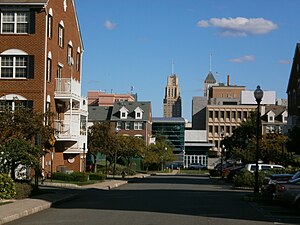
University Heights is a neighborhood in Newark in Essex County, in the U.S. state of New Jersey. It is so named because of the four academic institutions located within its boundaries: Rutgers University (Newark Campus), New Jersey Institute of Technology (NJIT), New Jersey Medical School (Rutgers) and Essex County College. In total, the schools enroll approximately 30,000 degree-seeking students.
The University Heights neighborhood is roughly bounded by University Avenue to the east, Orange Street to the north, Bergen Street to the west, and South Orange Avenue to the south. The schools are involved in the development of University Heights Science Park, a major research complex to be located between their campuses. The Public Health Research Institute on Warren Street relocated there in 2002.[1][2] The area is home to Science Park High School as well. BioTrials, a French biological research company is one of the first firms to locate there. They are located in a seven story newly constructed building on Norfolk St.
Rutgers and NJIT have expanded considerably since the 1960s. Prior to this expansion, University Heights was one of the more affluent residential neighborhood of Newark. The area has one of Newark's few concentrations of brownstones. The gym at Essex County College was home of the American Basketball Association team, the Newark Express, which moved to Drew University and became the Jersey Express after averaging some 150 fans per game in Newark, though it attracted even fewer at Drew.[3] The area is home to the Paul Robeson Galleries at Rutgers University[4] and the Weston Museum in the Van Houten Library at the New Jersey Institute of Technology, which includes artifacts from inventor Edward Weston, an early challenger of Thomas Edison.[5]
One of the main north-south thoroughfares of University Heights is Martin Luther King, Jr. Blvd. (formerly High Street) home to many historic buildings. Eberhardt Hall at NJIT, St. Mary's Abbey Church, Essex County Hall of Records, and Essex County Veterans Courthouse are among Newark's registered historic places, as is the former Essex County Jail.[6] The neighborhood is served by the Washington Street, Warren Street/NJIT, and Norfolk Street stations of Newark's Light Rail which links to Manhattan via the PATH and NJTransit rail systems at Newark's Penn Station.

- ^ Garbarine, Rachelle. "In the Region/New Jersey; Newark's Science Park Takes Another Step Forward", The New York Times, November 23, 1997. Accessed April 16, 2012. "WITH $60 million in state financing and leases from three tenants in place, plans are moving forward on a 161,600-square-foot medical research building that will anchor the second phase of development at the 50-acre University Heights Science Park in Newark's Central Ward."
- ^ Economic and Community Development Initiatives Archived 2010-05-27 at the Wayback Machine, University of Medicine and Dentistry of New Jersey. Accessed April 16, 2012.
- ^ Santiago, Katherine. "Jersey Express to play at East Orange high school gym for upcoming season", The Star-Ledger, August 26, 2009. Accessed April 16, 2012 ."The Express moved in 2007 to Morris County after two years in Newark as the Newark Express. Team officials hoped for a surge in attendance above the average 150 fans a game they drew at Essex County College."
- ^ Paul Robeson Galleries, Rutgers University. Accessed April 16, 2012.
- ^ The Weston Museum Archived 2012-04-25 at the Wayback Machine, New Jersey Institute of Technology. Accessed April 16, 2012.
- ^ "New Jersey and National Registers of Historic Places – Essex County" (PDF). NJ DEP – Historic Preservation Office. November 10, 2010. p. 3. Archived from the original (PDF) on March 27, 2009. Retrieved May 13, 2010.